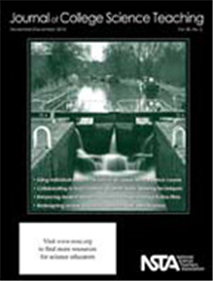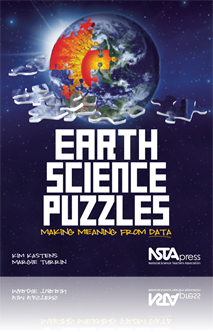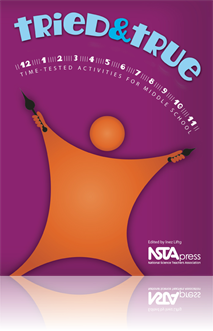All Resources
Journal Article
Building Models to Better Understand the Importance of Cost Versus Safety in Engineering
While some disasters involving engineered structures are due to events in nature (e.g., tornadoes, hurricanes, earthquakes), others may be caused by inadequate materials, design flaws, and poor maintenance. These catastrophes result in the loss of hu...
Journal Article
The Effectiveness of a Case Study-Based First-Year Biology Class at a Black Women’s College
The authors used a case study-based approach in the introductory biology course at Spelman College. The course taught to entering freshmen was divided into three modules—ecology, evolution, and biodiversity, each designed around a case study. They ...
Journal Article
Society for College Science Teaching: Finding Your Voice
In this month’s column, the author briefly outlines a few of the benefits of having a Society of College Science Teaching (SCST) membership. She hopes that college science faculty looking for a professional society to support and promote their inte...
Journal Article
Implementation of an Explicit and Reflective Pedagogy in Introductory Biology Laboratories
Students need to reflect on the practice of science to fully understand the nature of science (NOS), which is an important component of scientific literacy. In this paper, the authors describe how to implement an explicit and reflective pedagogy in c...
Journal Article
Clickers were used for real-time data collection in two introductory biology laboratory courses so that students could perform statistical analysis on large data sets. Student attitudes toward this use of clickers were surveyed and students were admi...
Journal Article
Teaching Through Trade Books: Unusual Creatures
Triops, also called tadpole shrimp, are tiny aquatic animals that are easy to raise and fun to watch. Their rapid growth rate, underwater acrobatics, and entertaining feeding behaviors make these inexpensive and readily available animals well-suited ...
Journal Article
This article provides an instructional approach to helping students generate open-inquiry research questions, which the authors call the open-inquiry question template. This template was created based on their experience teaching high school science ...
Journal Article
Methods and Strategies: Developing Persuasive Voice in the Science Classroom
This article examines the role of argument in the science classroom and how it can be used to help students develop science process skills (e.g., using evidence to defend a point of view) and literacy process skills (e.g., using language precisely to...
Book Chapter
How Do We Know What the Climate Was Like in the Past?
In this Data Puzzle, students interpret a multiparameter graph of pollen data from a sediment core collected in the northeastern United States to assess changes that occurred in the tree community over a period of about 7,000 years. By comparing the ...
Book Chapter
How Do We Decide ''Weather'' Or Not To Proceed With a Trip?
In this Data Puzzle, students will observe how temperature, dew point, pressure, and wind direction change over time, and they will interpret this suite of related changes as due to the passage of a cold front. They will recognize relationships among...
Book Chapter
What Does an Earthquake Feel Like?
In this Data Puzzle, students examine real newspaper accounts of the August 10, 1884, earthquake in the northeastern United States and gain firsthand experience applying the Modified Mercalli Intensity Scale to the event. Students gain insight into ...
Book Chapter
Is the Hudson River Too Salty to Drink?
In this puzzle, students examine three different sets of salinity data collected from the Hudson River estuary in New York. The puzzle includes data collected along the length of the estuary on the same date; data collected over a span of days that...
Book Chapter
In this Data Puzzle, students calculate the amount of precipitation that fell in a watershed over the course of one year and the amount of water that exited from that watershed via the outflow stream. They then compare these two values and draw on th...
Book Chapter
How Much Heat is Released by a Seafloor Hydrothermal Vent?
In this Data Puzzle, students compare the amount of heat given off by a hydrothermal vent with the amount of heat needed to bring a kettle of water up to boiling temperature. Recognizing that the heat released from one vent in an hour would heat a cu...
Book Chapter
How the Brain Visually Perceives the World
These classic activities explore how our eyes and brain receive and process visual information. Each activity requires approximately five minutes. For a richer experience with these activities, consult a neuroanatomy guide with labeled images of the ...
Journal Article
Scope on Safety: Blueprint for safety
If your lab facilities are going to be replaced or renovated, you should insist that the science instructors be involved in the process from planning to construction. You know what you’ll need in a facility, and your input should be sought out by a...
Journal Article
Armed with a few topical and organizational strategies, primary grade teachers can successfully introduce their young scientists to science notebooks. The following overview of notebook methods offers a menu of options to help you develop creative an...
Journal Article
During Cave Week, more than 200 students explore a simulated cave environment and participate in cave-related activities. Active cavers from a local club bring in equipment and photos and speak about their caving experiences. As student groups explor...
Journal Article
Formative Assessment Probes: Does It Have a Life Cycle?
If life continues from generation to generation, then all plants and animals must go through a life cycle, even though it may be different from organism to organism. Is this what students have “learned,” or do they have their own private concepti...








